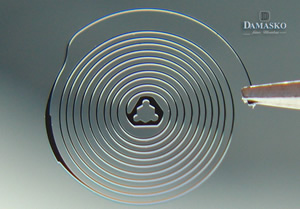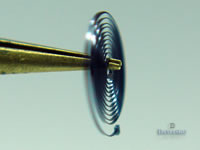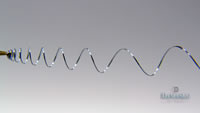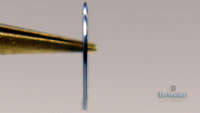Damasko Watch Technology
EPS-Spring
Isochronism is the essential element of any chronometry based on oscillations of whatever kind: the oscillations of a pendulum, a quartz crystal or a balance. The more regular the oscillation occurs, the more regular is the movement rate and the better can it be adjusted for best possible accuracy. If a control mechanism oscillates fully regularly, it is called isochronous (Greek for “occurring at equal intervals”).In this context, isochronism of the classical balance on transportable mechanical watches has proven to be the greatest challenge for watchmakers and engineers.
Major interference factors include primarily:
- the asymmetric development (transient and dying out oscillation, resp. breath) of the spring
- the change in the elasticity of the spring depending on the temperature
- the influence of magnetic noise fields
- mechanical and thermal changes to the material at both fixation points of the spring
- the influence of the centrifugal and gravitational force on the spring
- the unbalance of the balance wheel
- the play between the regulator pins
The properties of the EPS® material alone do not suffice to solve the phenomenon of asymmetric development of a flat spiral spring. For this reason, Damasko researchers looked for a method and found one in a new type of end curve design, which could be realised within the oscillatory level of the spring. This is shown in an obvious thickening at the outer end, which forces the EPS® spring into a concentric development, as a result of which the transient and dying out oscillation occurs symmetrically to the centre of the spring on all sides of the oscillatory level. This ideal form of thickening was registered as a patent.
The EPS® spring is manufactured in one piece, which means that is has an integrated collet for fixation to the balance staff, and at the outer end it is “clipped” into the stud in a very precisely defined area. The minute clamping jaws of this stud are designed resilient, so that the clip-on point of the spring can still be corrected by pulling or pushing the spring through the stud. This new type of stud design was registered as a patent.
On conventional springs, the inner end is affixed to the collet by soldering, welding or clamping. This causes a structural modification of the spring material at the fixation points due to squeezing or heating, which on the other hand requires additional adjustment works.
With the EPS® spring, Damasko has created an oscillating mechanism that provides multiple decisive advantages: the EPS® spring oscillates ideally concentric. It is designed for isochronism independently of the temperature, of the position of the movement and of magnetic fields.
EPS® springs with uniformly identical quality:
As in the case of the silicon escape wheel, the EPS® spring is produced in a DRIE (deep reactive ion etching) process, which is described in more detail at a later stage. The material has a uniformly fault-free polycrystalline structure and can be machined with tolerances in the micrometer range. Accordingly, all EPS® springs are of uniformly consistent and extremely high quality, which is transferred onto to the accuracy of the movements fitted with these.
The EPS® spring is the result of the consistent innovative policy of Damasko manufacture. With this development, Damasko is amongst the leaders in innovation and at the same time sets decisive accents in order to furnish its novelties with an exclusiveness that is typical to the brand using significant distinguishing features. Also in the case of the EPS® spring, it is the objective of this innovative philosophy to increase the accuracy and stability of mechanical watches, as well as raise the durability and sustainable value of Damasko watches.
EPS® spring by Damasko at a glance:
- Produced by deep reactive ion etching (DRIE) method and registered as a patent
- Concentric development that improves isochronism on the basis of a geometry that is registered as a patent
- Anti-magnetic
- Temperature compensation due to material properties
- Contrary to conventional springs, no thermal or mechanical impairment at fixation points
- Insensitivity to minor shocks
- Reduced sensitivity to centrifugal and gravitational forces, as the EPS® is three times lighter than conventional springs
- No impairment of movement rate due to recurrent minor shocks in daily use
- Complies with NIHS standards for coincidental standardised shocks




